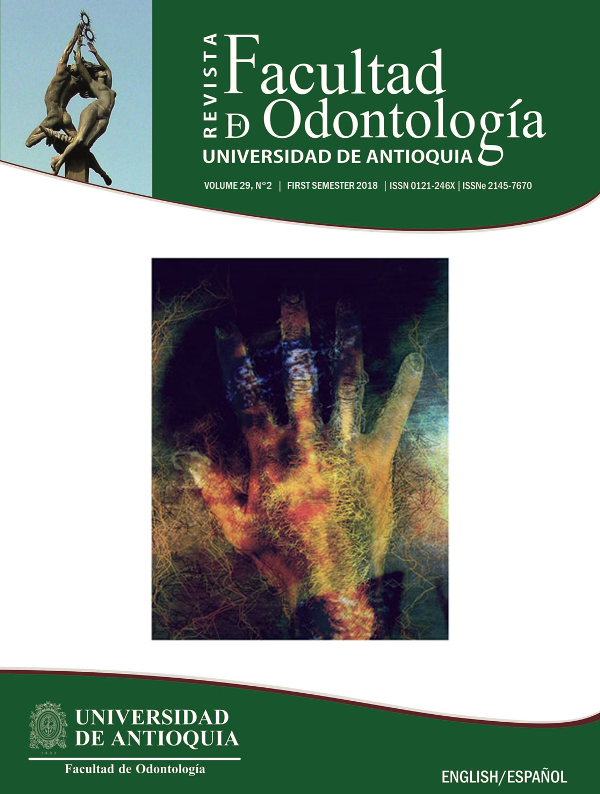The teaching of dentistry in the 21st century: where are we heading to?
DOI:
https://doi.org/10.17533/udea.rfo.v29n2a12Keywords:
Education, Teaching, Health, Empath, DentistryAbstract
The 21st century has brought swift changes in organizations, due in part to current exponential technological advances. The academic programs in health are not an exception and the teaching in these areas has also been adapting to such changes. However, dentistry is rooted in medicine, whose systematic format stems from Ancient Greece. Empathy is a key element not only for patient-physician relationships but also for treatment success, so our dental teaching must pay attention to this element, which is often neglected because of our current “high-performance culture”.
Downloads
References
Nicolescu R. The influences of globalization on educational environment and adjustment of national systems. Procedia Soc Behav Sci. 2015; 180: 72-79. DOI: https://doi.org/10.1016/j.sbspro.2015.02.088
Dávila-Cervantes A. Simulación en educación médica. Inv Ed Med. 2014; 3(10): 100-105
Ramírez-Skinner H. ¿Y antes de Fauchard qué? La odontología en las cavernas, los templos, los hospitales y las universidades. Rev Clin Periodoncia Implantol Rehabil Oral. 2012; 5(1): 29-39. DOI: http://dx.doi.org/10.4067/S0719-01072012000100006
McHarg J, Kay E. Designing a dental curriculum for the twenty-first century. Br Dent J. 2009; 207(10): 493-497. DOI: https://doi.org/10.1038/sj.bdj.2009.1011
Keskin SC. From what isn’t empathy to empathic learning process. Procedia Soc Behav Sci. 2014; 116: 4932-4938. DOI: https://doi.org/10.1016/j.sbspro.2014.01.1052
Pedersen R. Empathy development in medical education – A critical review. Med Teach. 2010; 32(7): 593-600. https://doi.org/10.3109/01421590903544702
Elani H, Allison P, Kumar R, Macini L, Lambrou A, Bedos C. A systematic review of stress in dental students. J Dent Educ. 2014; 78(2): 226-242.
Kang I, Foster-Page LA, Anderson VR, Thomson WM, Broadbent JM. Changes in students' perceptions of their dental education environment. Eur J Dent Educ. 2014; 19(2): 122-130. DOI: https://doi.org/10.1111/eje.12112
Jain A, Bansal R. Stress among medical and dental students: a global issue. IOSR-JDMS. 2012; 1(5): 5-7.
Von-Marttens A, Carvajal J, Leighton Y, Von-Marttens M, Pinto L. Experiencia y significado del proceso de edentulismo de adultos mayores, atendidos en un consultorio del servicio público chileno. Rev Clin Periodoncia Implantol Rehabil Oral. 2010; 3(1): 27-33. DOI: http://dx.doi.org/10.4067/S0719-01072010000100005
Hemmerdinger JM, Stoddart SD, Lilford RJ. A systematic review of tests of empathy in medicine. BMC Med Educ. 2007; 7(1): 24. DOI: https://doi.org/10.1186/1472-6920-7-24
Merfat-Ayesh A. Hidden curriculum as one of current issue of curriculum. J Educ Pract. 2015; 6(33): 125-128.
Useche-Aldana Ó. Jóvenes y productividad: las nuevas formas del trabajo y el problema del desarrollo humano. Polis (Santiago). 2009; 8(23): 195-224.
Downloads
Published
How to Cite
Issue
Section
Categories
License
Copyright (c) 2018 Revista Facultad de Odontología Universidad de Antioquia

This work is licensed under a Creative Commons Attribution-NonCommercial-ShareAlike 4.0 International License.
Copyright Notice
Copyright comprises moral and patrimonial rights.
1. Moral rights: are born at the moment of the creation of the work, without the need to register it. They belong to the author in a personal and unrelinquishable manner; also, they are imprescriptible, unalienable and non negotiable. Moral rights are the right to paternity of the work, the right to integrity of the work, the right to maintain the work unedited or to publish it under a pseudonym or anonymously, the right to modify the work, the right to repent and, the right to be mentioned, in accordance with the definitions established in article 40 of Intellectual property bylaws of the Universidad (RECTORAL RESOLUTION 21231 of 2005).
2. Patrimonial rights: they consist of the capacity of financially dispose and benefit from the work trough any mean. Also, the patrimonial rights are relinquishable, attachable, prescriptive, temporary and transmissible, and they are caused with the publication or divulgation of the work. To the effect of publication of articles in the journal Revista de la Facultad de Odontología, it is understood that Universidad de Antioquia is the owner of the patrimonial rights of the contents of the publication.
The content of the publications is the exclusive responsibility of the authors. Neither the printing press, nor the editors, nor the Editorial Board will be responsible for the use of the information contained in the articles.
I, we, the author(s), and through me (us), the Entity for which I, am (are) working, hereby transfer in a total and definitive manner and without any limitation, to the Revista Facultad de Odontología Universidad de Antioquia, the patrimonial rights corresponding to the article presented for physical and digital publication. I also declare that neither this article, nor part of it has been published in another journal.
Open Access Policy
The articles published in our Journal are fully open access, as we consider that providing the public with free access to research contributes to a greater global exchange of knowledge.
Creative Commons License
The Journal offers its content to third parties without any kind of economic compensation or embargo on the articles. Articles are published under the terms of a Creative Commons license, known as Attribution – NonCommercial – Share Alike (BY-NC-SA), which permits use, distribution and reproduction in any medium, provided that the original work is properly cited and that the new productions are licensed under the same conditions.
![]()
This work is licensed under a Creative Commons Attribution-NonCommercial-ShareAlike 4.0 International License.













